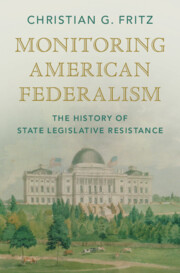Book contents
- Monitoring American Federalism
- Studies in Legal History
- Monitoring American Federalism
- Copyright page
- Dedication
- Contents
- Acknowledgments
- Introduction
- 1 The Riddle of Federalism and the Genesis of Interposition
- 2 Early State Use of Interposition: Testing the Powers of the New National Government
- 3 State Interposition and Debates over the Meaning of the Constitution
- 4 The Virginia and Kentucky Resolutions and Madison’s Report of 1800
- 5 State Interposition during the Jefferson and Madison Presidencies
- 6 State Challenges to the Supreme Court’s Control over Constitutional Interpretation
- 7 The Transformation of Interposition: The Theory of Nullification Emerges
- 8 State Interposition and Nullification on the Path to Secession
- 9 State Interposition during and after the Civil War
- 10 Modern Interposition by States and “Nullification”
- Abbreviations
- Notes
- Selected Short Titles
- Index
7 - The Transformation of Interposition: The Theory of Nullification Emerges
Published online by Cambridge University Press: 05 January 2023
- Monitoring American Federalism
- Studies in Legal History
- Monitoring American Federalism
- Copyright page
- Dedication
- Contents
- Acknowledgments
- Introduction
- 1 The Riddle of Federalism and the Genesis of Interposition
- 2 Early State Use of Interposition: Testing the Powers of the New National Government
- 3 State Interposition and Debates over the Meaning of the Constitution
- 4 The Virginia and Kentucky Resolutions and Madison’s Report of 1800
- 5 State Interposition during the Jefferson and Madison Presidencies
- 6 State Challenges to the Supreme Court’s Control over Constitutional Interpretation
- 7 The Transformation of Interposition: The Theory of Nullification Emerges
- 8 State Interposition and Nullification on the Path to Secession
- 9 State Interposition during and after the Civil War
- 10 Modern Interposition by States and “Nullification”
- Abbreviations
- Notes
- Selected Short Titles
- Index
Summary
The dispute over the Tariff of 1828 marked a turning point for interposition. State legislatures passed resolutions declaring protective tariffs unconstitutional, increasingly using more threatening language that echoed the doctrine of nullification John C. Calhoun advanced in the South Carolina Exposition of 1828. Calhoun’s arguments distorted Madison’s views and transformed traditional sounding the alarm interposition into an option for each state to nullify acts of the national government that it considered unconstitutional. Nullification prompted a national discussion about the nature of the Union, notably in the Webster–Hayne debate in the United States Senate in 1830.Nullifiers quoted the Virginia and Kentucky Resolutions and Madison’s Report of 1800 to justify their constitutional theory, but misunderstood Madison’s theoretical right of the people to interpose in the final resort and overlooked the sounding the alarm interposition of the resolutions. Madison rejected both nullification and secession and tried to explain what he meant by a complex federalism based on divided sovereignty, ultimately failing to correct misconceptions about his resolutions.
Keywords
- Type
- Chapter
- Information
- Monitoring American FederalismThe History of State Legislative Resistance, pp. 196 - 226Publisher: Cambridge University PressPrint publication year: 2023

